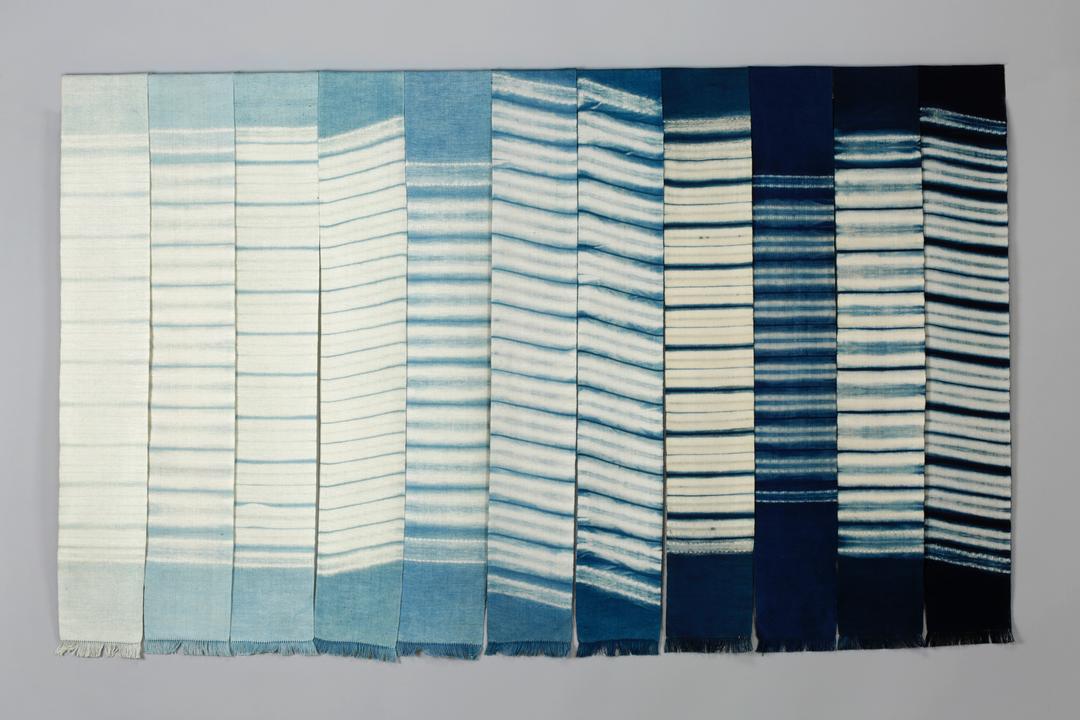Indigo Value Study
- Title
- Indigo Value Study
- Date
- 2021
- Dimensions
- 38” x 63”
- Media
- Handwoven textile utilizing cotton and linen yarns. The fabric incorporates woven shibori resist. Dyed with indigo.
Goal
The purpose of this study was to create a full range of values, from the lightest possible value to deepest indigo blue, on cotton/linen textiles. It was one of the most challenging undertakings as there are multiple variables in creating shades of indigo blue.
Explanation
Indigo is the only natural source of blue dye. The dye is insoluble in water unless in the form of a reduction vat. In this vat form, it is not possible to control the depth of color by determining the amount of dye per weight of fiber. Instead, control of the various tints and shades of blue necessitates that the dyer has the skill to manage variables that include:
- The vat itself
- What are the ingredients used to reduce the vat?
- The strength of the vat.
- How much indigo was initially used in the vat?
- How much has the vat been used?
- How much residual indigo might be left in the vat?
- The length of time the textile is immersed in the vat
- Longer dips result in a more thorough penetration of the fibers
- Shorter dips that do not penetrate the textile as well may be used to achieve paler colors
- How many times has the textile been immersed in the vat?
- Layers of indigo dye are built up on the textile by repeated dips in the vat. Added dips result in darker colors.
[Note: I always immerse a textile at least 3 times. Repeated immersions are required to achieve even dyeing. The deepest shades of blue were immersed in the vat 24 times, for 10 minutes per immersion.]
The process of achieving 12 values of indigo also requires a critical eye and the ability to visually differentiate the values.
The Method
All medium and dark shades in this collection were dyed in a naturally fermented vat that used indigo pigment, wood ash lye, wheat bran and indigo plant material to develop the fermentation. These vats utilized 8-10 grams of indigo pigment/liter. All indigo was sourced from Stony Creek Colors. Be sure to source your indigo from a reputable supplier.
I had assumed that the lightest blues could be dyed in the same vat after the strong vats were used for dyeing and the amount of indigo diminished. Yet after more than a year of steady use, the vats never became weak enough to produce the light colors that I was searching for. I made a new, weak vat (1 g of indigo per liter) with fructose and lime for short term use in order to accomplish the desired “pale” colors.
Results
The blues produced by the fructose vat are slightly different in tone from the darker shades that are dyed in the fermentation vat. The additional plant material in the fermented vats seems to result in a more complex shade of blue. Likely this is a result of the additional plant materials in the vat.
Further Research
Antoine Janot, 18th century professional wool dyer from France, documented and regularly used 7 different shades of blue. Each of them had a name, such as “Crow’s Wing” (nearly black) to “Off White Blue” (the very palest). Control over these various shades was in important first step in achieving greens, violets, grey and black tones. This is well documented in Workbook, Antoine Janot’s Colours by Dominique Cardon and Iris Bremaud. (CNRS Editions, 2020/ISBN 978-2271132932). This small book was the inspiration for much of my own work in color development and mixing with natural dyes and deserves a place on the serious natural dyer’s bookshelf.
